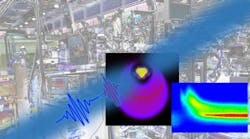Ultrashort XUV laser pulses can eject a single atom from a nanodroplet
A team headed by Frank Stienkemeier at The University of Freiburg's Institute of Physics and Marcel Mudrich at the University of Aarhus in Denmark has observed the ultrafast reaction of nanodroplets of helium after excitation with extreme ultraviolet radiation (XUV) using a free-electron laser in real time.1
Lasers generating high-intensity ultrashort XUV and X-ray pulses give researchers new options for investigating the fundamental properties of matter in great detail. In many such experiments, material samples in the nanometer range are of particular interest.
Some scientists use helium droplets no larger than a few nanometers as a means of transporting and studying embedded molecules and molecular nanostructures. Helium droplets are ideally suited for this purpose because they possess extraordinary properties. At a temperature of only 0.37 K, they move without friction and are thus considered superfluids. Moreover, helium droplets usually are inert to the embedded molecules' chemical processes and are completely transparent to IR and visible light.
The researchers wanted to find out how one of these superfluid droplets itself reacts when hit directly by an intense XUV laser pulse. The researchers used the world's first and only seeded free-electron laser FERMI (Trieste, Italy), which delivers high-intensity XUV pulses at a wavelength set by the team.
How to eject a single atom
Supported by model calculations, the researchers identified three elementary reaction steps: A very fast localization of electrons, the population of metastable states, and the formation of a bubble that eventually bursts at the surface of the droplets and ejects a single excited helium atom.
"This is essential information for work aiming at directly imaging individual nanoparticles," says Stienkemeier, "as it is being carried out at new intense radiation sources such as the European X-ray laser XFEL in Hamburg."
Source: https://www.eurekalert.org/pub_releases/2020-01/uof-nin010820.php
REFERENCE:
1. Mudrich, M. et al., Nature Communications 11 (2020); doi: 10.1038/s41467-019-13681-6.
Got optics- and photonics-related news to share with us? Contact John Wallace, Senior Editor, Laser Focus World
Get more like this delivered right to your inbox
About the Author
John Wallace
Senior Technical Editor (1998-2022)
John Wallace was with Laser Focus World for nearly 25 years, retiring in late June 2022. He obtained a bachelor's degree in mechanical engineering and physics at Rutgers University and a master's in optical engineering at the University of Rochester. Before becoming an editor, John worked as an engineer at RCA, Exxon, Eastman Kodak, and GCA Corporation.

